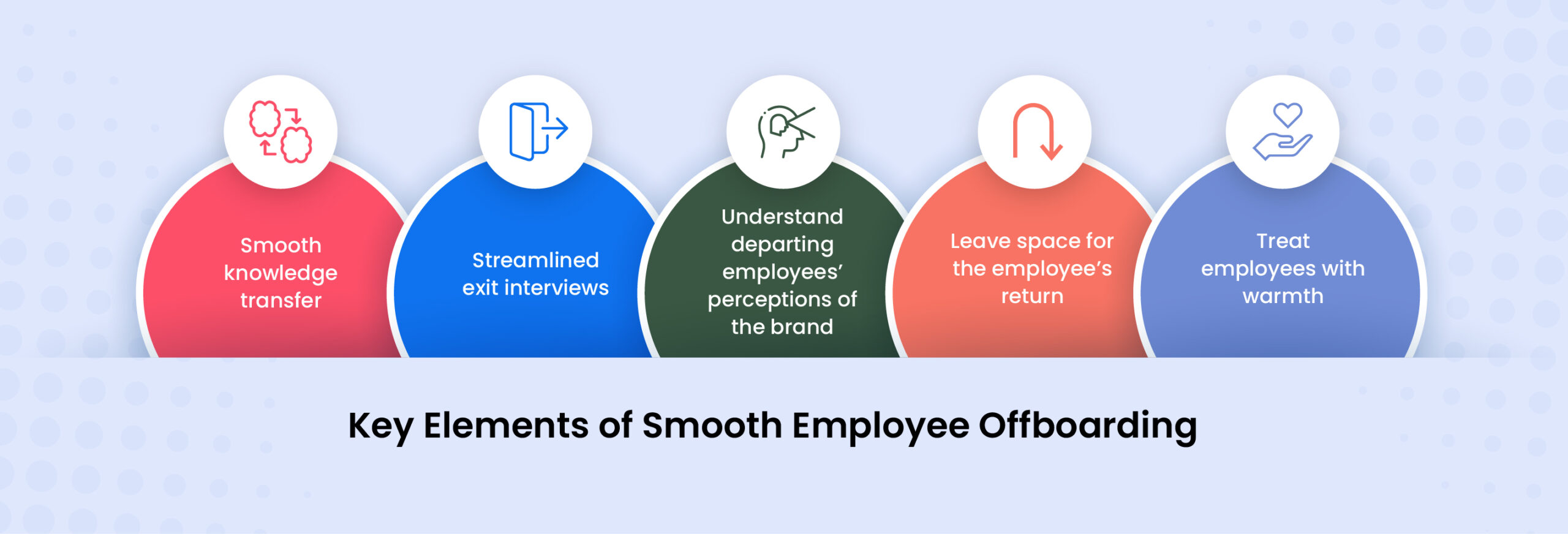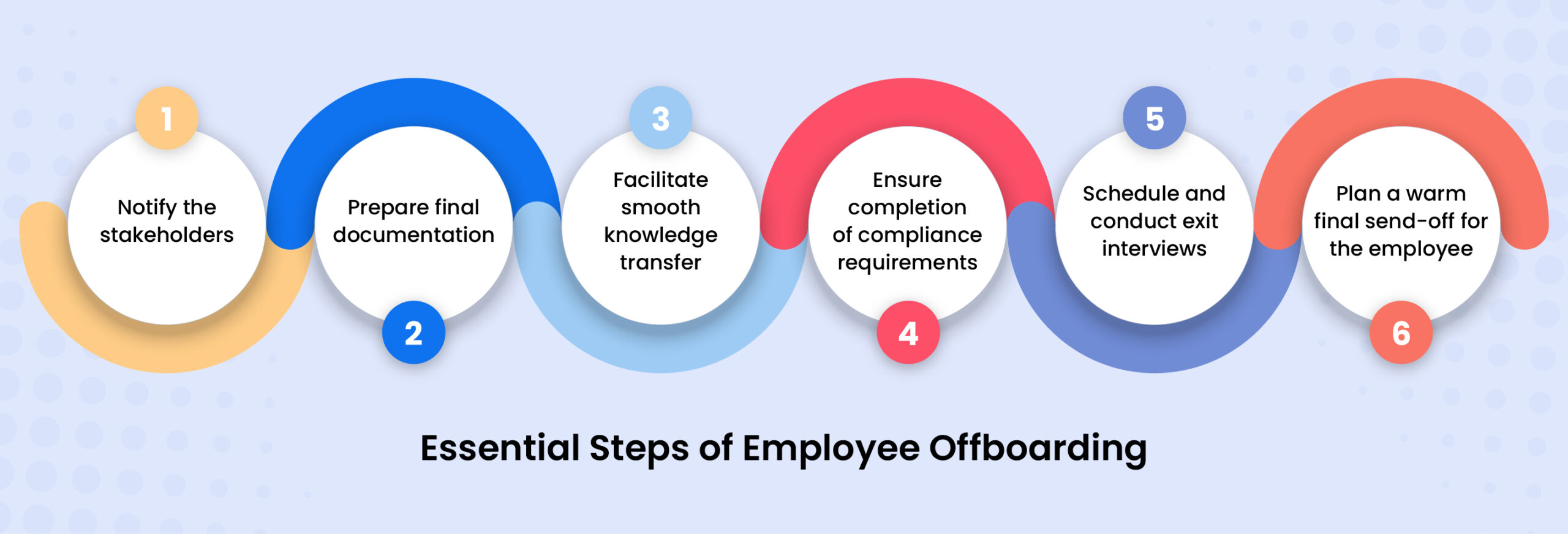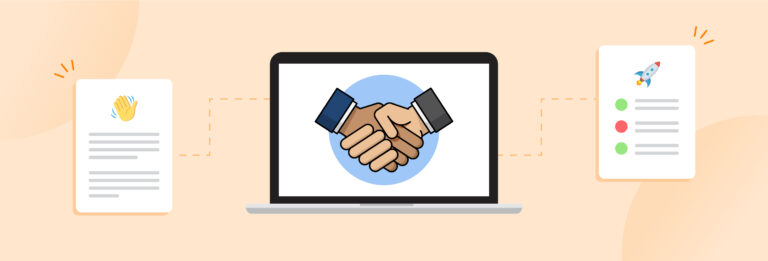Exceptional employee experience is crucial for every organization. From a new hire’s day one to the final sign-off, every employee needs to be provided a seamless experience using guidelines and roadmaps like an employee offboarding checklist. This is crucial in a company’s growth and journey to building a motivated workforce. However, to this day, offboarding remains a neglected process.
Only 29% of organizations have set up a formal offboarding process or follow an offboarding checklist. But with a great resignation in the midsts, employee offboarding is a crucial step in the employee lifecycle. Similar to how good first meetings boost productivity and retention, an excellent last impression can leave the employees feeling good about the organization. This also increases the chances of making their return or becoming the company’s brand ambassador.
This blog will detail the framework of a good offboarding process. It will also provide a checklist to ensure smooth exits of employees.
What does a good employee offboarding process look like?

Employee offboarding is not just about bidding goodbye to an employee. It is an important stepping stone for both stakeholders involved and an opportunity to understand the reason behind their resignation, take corrective measures, and provide help wherever possible. Done poorly, it can be highly risky for the company. Therefore, the process must be structured, systematic, and should follow offboarding best practices.
Here are the key elements of a well-planned employee offboarding process with offboarding best practices:
- Smooth knowledge transfer: Facilitate a smooth transfer of the departing employee’s knowledge to the new hire. Make it simple to ensure there is no skill gap after leaving the company.
- Streamlined exit interviews: Exit interviews are a great opportunity for HRs to understand the reason for the exit. It is also a stepping stone for the leaving employee to come full circle. With a clear offboarding process, the HR team can use these insights to rectify the shortcomings in the company’s employee engagement and take measures to improve them.
- Understand departing employees’ perceptions of the brand: Exit interviews allow HRs to know if the former employees have any negative perceptions of the company so they can clear them before they leave the organization.
- Leave space for the employee’s return: A smooth and memorable offboarding process leaves the door open to former employees who might return to the company at a later stage.
Treat employees with warmth: If the first impression determines the perception of the brand, the offboarding process will be what the employee carries with them to their new venture. Instead of being annoyed with your employees, treat them warmly, irrespective of the reason behind their resignation. Appreciate them for their efforts and contributions to the organization.

Factors to consider when creating an employee offboarding checklist
Here’s how an effective offboarding checklist can lead to an optimal employee experience.
-
Ensure no data is lost in transition
The last days of an employee in an organization are chaotic — there are tons of papers to be signed, formalities to be completed, and knowledge to be transferred. It is, therefore, crucial to have a streamlined process that facilitates the transfer of data without hitch. To bring order, an offboarding checklist can help make things hassle-free.
-
Ensure all compliances are met
Legal formalities and documentation though tedious are an integral part of the employee offboarding process. Payment breakdown, PF calculation, bonus calculation, and making sure the employee signs all NDAs and documentation—all of these processes need to be rolled out flawlessly.
Delays or hitches in the process mean a hassle for the leaving employee and delays in offboarding process closure for HR. Therefore, it is crucial to ensure that the full and final settlement does not have any glitches.
-
Ascertain morale does not go down
The offboarding checklist should create processes that the employee feels easy with the whole process. It does not matter why the employee is resigning. Therefore, it is necessary to make them feel good before they leave. The onboarding process should be crafted to make them feel proud of the work that they did at the company.
-
Safeguard current relationships
The final sendoff should ensure that the relationship built at the company is maintained and offboarding best practices are followed. Rather than leaving a bitter aftertaste and making things hard on their last working day, showcase appreciation with a memorable employee offboarding process.
-
Conduct a productive exit interview process
The final interview of the candidate is what they will carry forward with them. It is a great chance to ensure that the employee leaves on a good note and with a great impression of the company. HRs should have a streamlined process to ensure that exit formalities and interviews are conducted on time.
Employee offboarding essential steps and checklist

An employee offboarding checklist lays out the necessary steps and processes that govern the process of three key areas: leaving experience, company brand image, and data security. A well-designed checklist will therefore ensure the highest standards of the activities and facilitate easy coordination between stakeholders.
Here is a list of activities that are a must include in the offboarding checklist:
-
Notify the stakeholders
On first information of the employee’s departure, the first course of action needs to be notifying other departments to have a successful offboarding process. For example, once the IT department receives the information, they can plan timelines to close user accounts and collect company assets. At the same time, the payroll department can start calculating the full and final settlement remuneration. This will ensure the employee’s final paycheck is not overdue or if the employee needs to pay back any relocation fees or sign-on bonuses.
Whether the plan is to disclose the news during a team meeting or via email, the event needs to be straightforward and factual. It is necessary to state why the employee will be leaving the team, his/her last working day, who will replace the departing employee, and who to contact with questions.
-
Prepare final documentation
Documentation is a lengthy but necessary process that needs to be executed flawlessly. Before an exit process starts, the following documents should be made ready.
- A signed letter of resignation or termination clearly stating the reasons for departure
- Non-disclosure agreements which protect both the employer and employee
- Benefits and tax documents
- Severance package agreement
- Letter of recommendation
These documents should be prepared ahead of time and stored in the organization’s applicant tracking system. It must be ensured that everything is appropriately dated and physical copies are provided when necessary.
-
Knowledge transfer and training
When an employee leaves the organization, they carry a lot of knowledge and experience with them about the company and their job role. Therefore, the departing employee must be given enough time and resources to transfer their learnings to the next hire by recording essential information or mentoring the successor.
It’s the responsibility of HRs to ensure that this knowledge is appropriately organized and ready for the next hire through guides. This can be a great way to give the new employee an idea about various aspects of their role that might not be covered in a standard training course.
-
Ensuring completion of compliance requirements
Compliance requirements are a lengthy process consisting of multiple documentation. For both the organization and the candidate it is essential to complete all statutory requirements before the final day. This will reduce waiting time in offline correspondence and errors associated with it.
-
Scheduling and conducting exit interviews
Exit interviews are significant for the leaving employee and the organization. For the candidate, it is an opportunity to take away an impressive experience letter. For the company, it is a chance to understand the purpose of attrition.
HRs should take care to schedule exit interviews with relevant stakeholders on time. While setting up the interviews, care should also be taken to space the sessions out. This will ensure that the candidate is not overwhelmed.
-
Planning a warm final send-off for the employee
The final day is an emotional moment for the leaving employee. It is important to make sure that the employee is celebrated for their achievements in the company.
A well-organized function or send-off should be planned. Having various team members and managers that the employee is close to at the function will also make the day memorable.

How to automate your employee offboarding checklist
Handling HR processes manually can impact the overall business. HR managers who don’t automate employee processes experience lower productivity, gaps in following offboarding best practices, poor employee experience, less engagement, and higher costs.
Follow these steps to automate and tick the boxes of your employee offboarding checklist:
-
Get an HR automation tool
An employee offboarding checklist can simplify the coordination of tasks and make one person responsible for getting the tasks done. The process can be streamlined further with an HR automation tool.
The benchmark should be an HR tool that will simplify the complete offboarding process of the employee without any loose ends. This will ensure that all data and documentation are stored in one place, and data does not move from one tool to another, reducing delays in the process. Leena AI’s Employee Offboarding offering ticks all the boxes. It allows HR teams to create a positive and seamless offboarding experience by sending necessary documents automatically, ensuring policy compliance, and enhancing accuracy.
-
Define a unique offboarding plan for each team
Once you know an employee is leaving your organization, draft an offboarding plan regarding communicating the news to the stakeholders and the rest of your team. Create a list of steps to ensure a complete offboarding and assign the tasks to the concerned people.
Further, each team should clearly define its steps, tools, and offboarding processes as these may vary from one team to another. For example, social media teams may only need to hand over social media accounts while others may require returning IT equipment, software credentials, etc.
-
Automate the process
Automation is critical to streamlining the end-to-end process of offboarding employees.
From sending out a checklist of tasks to complete when leaving to collecting necessary documents, automating the communication and follow-ups can help HRs create and manage a talent pool of departing employees. Plus, it reduces the time and effort the HR has to put in and ensures nothing is missed.
Successful automation also makes it easy for departing employees to track how much offboarding is left, so they don’t feel overwhelmed and confused during their last working days.
-
Learn and optimize
Designing an effective employee offboarding process can work wonders in providing a positive experience to the departing employees. However, it’s not something you should set and forget.
Conduct exit interviews and gather feedback from the employees about how the offboarding process worked out for them. Learn from their experience and improve strategy.

Summing up
When an employee leaves, their journey with the organization ends. But that doesn’t mean it is a full stop to relations. They are great brand ambassadors and provide direction for making the company better. Therefore, one must never ignore the offboarding process.







2 Comments